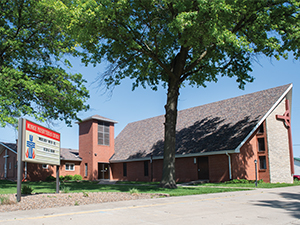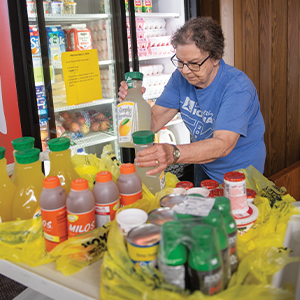Ann Johnson is the pastor for Monroe Presbyterian Church, and the director of the PCM Food Pantry. She said the generosity of surrounding communities keeps the pantry stocked with important staples like eggs, milk and meat.
Writer: Mike Mendenhall
Photographer: Duane Tinkey
The number of monthly visits to the PCM Food Pantry in Monroe is rising.
The rural Iowa food pantry in southern Jasper County, which has served Monroe, Prairie City and Reasnor out of the Monroe Presbyterian Church since 2003, has seen the number of people it serves slowly tick up since mid-2022. Director Ann Johnson attributes the rise to the expiration of COVID-era government stimulus programs and the end of emergency allotments of the Supplemental Nutrition Assistance Program (SNAP).
Rural Iowa counties face some of the state’s highest rates of food insecurity. For example, in Appanoose County, which includes Centerville and Honey Creek State Park, nearly 15% of its 1,830 residents face food insecurity, according to 2022 data from Feeding America’s annual Map the Meal Gap study, the most recent information available.
By comparison, Polk County in the Des Moines metro area recorded 10.2% of its population as food insecure, including 19,180 children. The study shows nearly 11% of all Iowans and 15.4% of Iowa children don’t have steady, reliable sources of food.
According to Food Bank of Iowa CEO Michelle Book, the nonprofit and its partner organizations are working to increase the number of school-based food pantries as a way to make food more accessible in rural areas. In many small towns, transportation and shuttered grocery retailers create persistent obstacles to food security.

Monroe Presbyterian Church
A Network of Help
The PCM Food Pantry in Monroe is part of the Food Bank of Iowa’s partner pantry network spread over 55 counties. Whatever the pantry cannot fill through the Food Bank, volunteers supplement through church drives, community donations and purchases through the local Monroe Foods grocery store.
“We’ve always been able to keep up, but that’s because of the generosity of the communities,” said Johnson, who has led the pantry since 2011 and is the Monroe Presbyterian Church pastor.
Despite the challenges in rural Iowa, Johnson said the PCM pantry has maintained its status as a “choice pantry,” allowing its customers to select anything from the facility’s inventory. Johnson said that minimizes waste and helps visitors maintain a sense of dignity.
“We found this out during the pandemic because we had to do packed bags for a while,” Johnson said. “It’s important for us to offer people a chance to choose, to always have an opportunity for eggs, milk and bread — and we always have meat.”

Sheila Swarts volunteers at the PCM Food Pantry packing items from the meat freezer for visitors.
Growing School Pantries
After a partner community conference in April in Albia, Book and her team visited an in-school food pantry at the Albia Community School District’s Lincoln Center, one of 150 school pantries in the Food Bank’s network.
She said the facility in a converted classroom is reminiscent of a small-town grocery store with shelves and freezer chests, serving 30 to 40 households per week. According to Book, the pantry had ordered about 6,000 pounds of food from January through April – almost half of what it distributed in all of 2023.
“The line starts forming outside the school at about 1:30 p.m., and there are so many people from the community coming in they have to ask them to wait in the parking lot so the kids could get in and out of the school at the end of the day,” Book said.
The Alliant Energy Foundation, the independent philanthropic arm of the Madison, Wisconsin-headquartered utility Alliant Energy Corp., recently announced it would provide $1 million over two years to combat hunger in Iowa and Wisconsin. The program is partnering with the Food Bank as well as HACAP Food Reservoir in eastern Iowa to expand school-based food pantries in seven rural counties: Appanoose, Clay, Jefferson, Keokuk, Union, Wapello and Wayne.
“We really think this is the best way to alleviate hunger for households with children,” Book said.
Since August 2023, resources from the Rural Hunger Initiative in Iowa have helped establish new school pantries at Clay Central Everly Community in Royal in Clay County, Creston Middle School in Union County, and the Ottumwa Gateway Center in Wapello County. Those pantries have distributed a combined 66,740 pounds of food, according to the foundation.
Book says food insecurity in Iowa is the highest it’s been since 2017. In 2022, the Food Bank launched an $11 million project to expand its Des Moines distribution center by 30,000 square feet, doubling its size. That’s in addition to the nonprofit’s 40,000 square feet of space in Ottumwa.
Food Bank leaders and its rural partner pantries said the demographics of its clients vary by region, but many of their users are working parents, people who are chronically unemployed or underemployed, and older residents.

Patty Dining, a volunteer, puts away items recently donated from the local Dollar General.
Other Philanthropic Solutions
Alliant Energy’s Iowa operation is based in Cedar Rapids, where the company serves both urban and rural customers. The utility operates more than 42,000 miles of electric lines and 9,600 miles of gas mains and employs nearly 4,000 people, according to the Iowa Utility Association.
According to Alliant’s foundation, its Rural Hunger Initiative will continue to expand programming through 2025 to develop resources, especially for rural schools and veterans.
The foundation’s senior community affairs program manager, Leah Rodenberg, said the foundation also operates a mobile pantry program to bring food to rural Iowans who don’t have easy access to transportation or can’t visit food pantries during regular hours due to their job schedules or other reasons.
“What you see at the mobiles, and this is true in different counties, you’ll see someone pick up for many families,” Rodenberg said. “It could be someone at church. The family is working or they can’t come to that mobile site at that certain time, so they’ll have other people and other family members help.”
Rodenberg said the foundation plans to announce a second program in its Rural Hunger Initiative to help food banks adopt new systems to acquire perishable foods like fresh chicken, beef, pork, dairy and produce from agricultural partners. The program is designed to support local farmers and ease access to healthy food for those who need it.
The foundation planned to highlight the program during a summit this summer with the Food Bank.
The idea, Rodenberg said, is to “help the food banks imagine, if money was not an issue, what they would really like to do to solve rural hunger challenges.”
Whatever the solutions, it’s important for pantries in rural Iowa to “stand in that gap,” pastor Johnson said. “When you’re sitting in farm country, it would be awful to not be able to offer somebody food when we’re in the middle of so much wealth in terms of our ability to grow stuff.”











